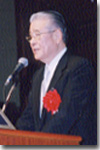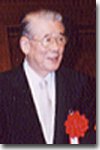Speech by Ikuo Hirayama (Japan / Artist)

Thank you very much for your most generous introduction, my name is Hirayama. First and foremost, I would like to extend my sincere gratitude for being awarded this prestigious award. I would like to offer my sincere gratitude to the members of the Japan Foundation, the past recipients, and the members involved in the nomination and selection process. At the same time, my heartfelt gratitude that goes to those of you in the audience who have graciously attended this event despite your busy schedule.
As was introduced earlier, I have been advocating peace through culture. During the Second World War, Japan made the Asia-Pacific region into a field for battle and caused an inordinate amount of inconvenience. Also, I was personally exposed to the atomic bomb in Hiroshima on August 6, 1945. Fortunately, I survived, but I was very much troubled by the after-effects of the radiation for many years afterwards. But I felt that such experience could be utilized, and in 1959 under the topic of the propagation of Buddhism, in wishing for peace, I have decided to produce various works of art. That became the starting point of my artistic activity.
The Silk Road: the crossroads between East and West. I have for many years, personally, walked the Silk Road; I have visited this area many, many times and been exposed to civil strife and clashes of various groups within the area. There are many cultural assets that celebrate the cultural ties between East and West, but unfortunately, as a result of the devastation of war and natural degradation, I have observed these wonderful cultural assets being falling into ruin. I have fostered a willingness to preserve these precious works of art.

Cultural assets are not just properties per se. People who live in the environs of these cultural assets also should be subject to our support; we should render our encouragement to those people. So with that in mind, I have begun to advocate the concept of the "Red Cross Spirit for Cultural Heritage." Members of the military who are injured as a result of the war are offered relief and support in a spirit of universal humanism. At the same time, various races and countries around the world, if they have wonderful, precious works of art, a legacy of art, someone should also render support to those countries and races. In the case of Japan, I personally believe we have learned a major lesson of history; peace, through culture, that is the lesson we have learned. So, such places as Angkor Wat in Cambodia, or the Dunhuang Caves in China are wonderful human heritage sites that are calling out for help in terms of preservation, and that is why I became involved in rendering support for their preservation. However, the ties between Japan and parts of the Korean Peninsula, are not at their best. There are considerations pertaining to peace in North Korea. But despite that situation, I have been offering support to the preservation of the Koguryo tomb frescos. Our ancient culture in Japan, the Nara culture, was very much connected to the Korean culture, particularly the Koguryo tomb frescos. Therefore, by preserving them, I hope that through culture, we will be able to realize a "soft landing" in terms of the relationship between Japan and Korea, and in terms of overall peace in East Asia.
The fact that the Japan Foundation was gracious enough to present me with this award for such activities is a great privilege for me. I do hope that in the future, I will continue to render whatever assistance I am able to offer in my capacity so that we may preserve these cultural assets and also help in fostering the next generation. I will consider it a great privileged if I am able to do that.
Thank you once again for this wonderful award, and for this ceremony. I would like to offer my sincere gratitude. Thank you.
- What We Do Top
- Arts and Cultural Exchange [Culture]
- Japanese-Language Education Overseas [Language]
- Japanese-Language Education Overseas [Language] Top
- Learn Japanese-language
- Teach Japanese-language
- Take Japanese-Language Test
- Know about Japanese-language education abroad
- The Japanese-Language Institute, Urawa
- The Japanese-Language Institute, Kansai
- Japanese-Language Programs for Foreign Specified Skilled Worker Candidates
- Japanese Language Education for Japanese Children Resident Overseas and for the Descendants of Migrants
- Archives
- Japanese Studies and Global Partnerships [Dialogue]
- JF digital collection
- Other Programs / Programs to Commemorate Exchange Year
- Awards and Prizes
- Publications
